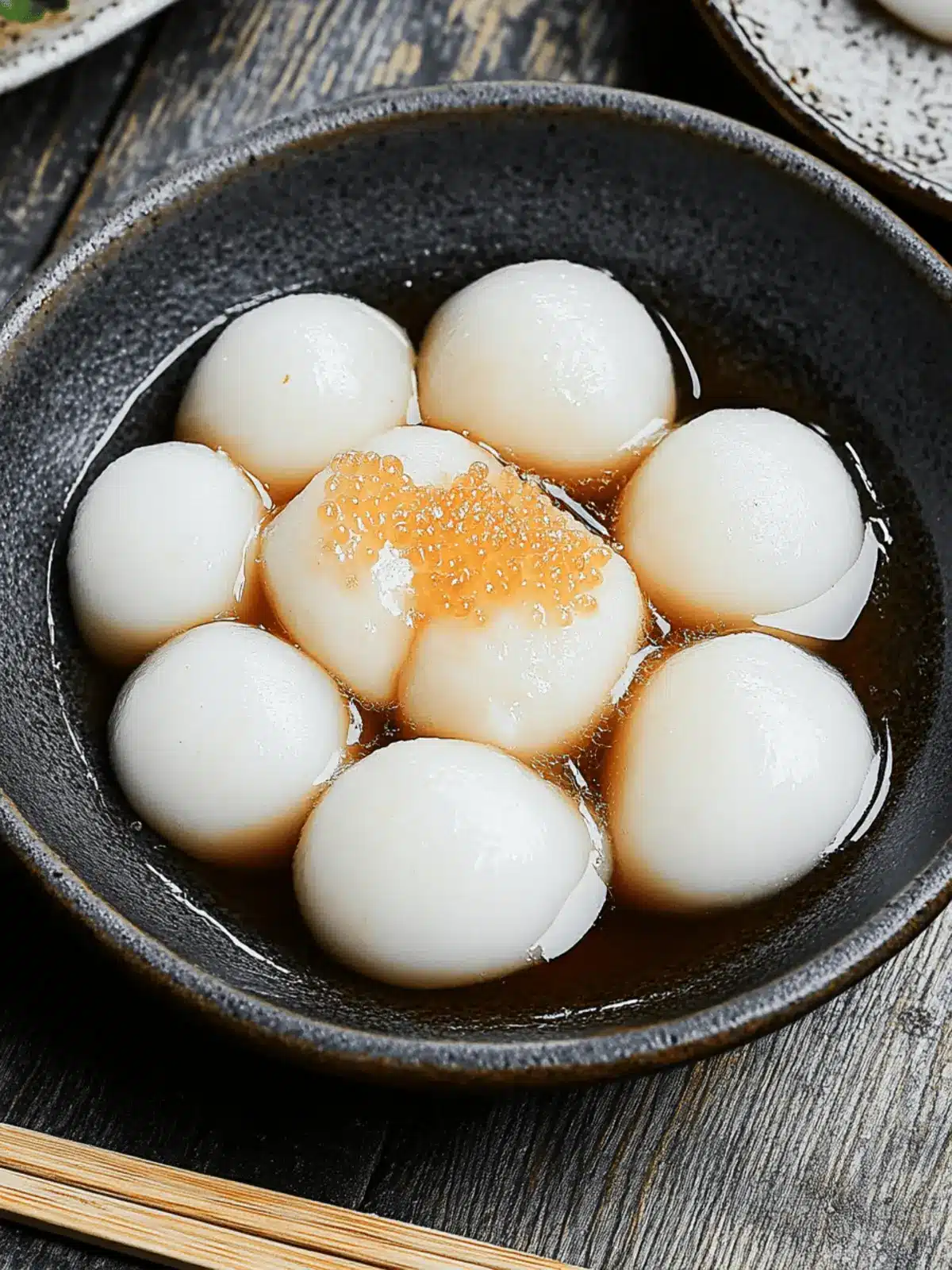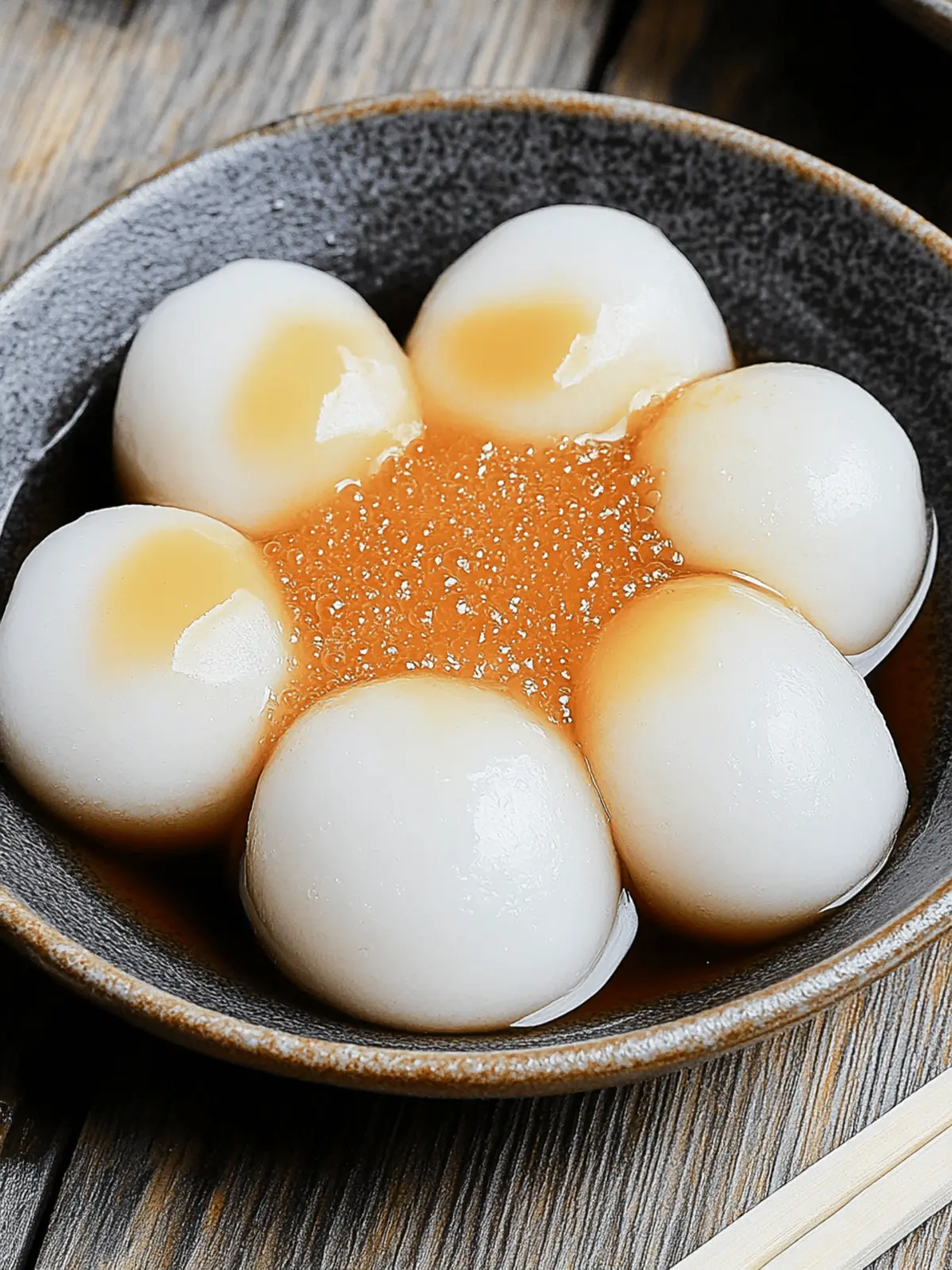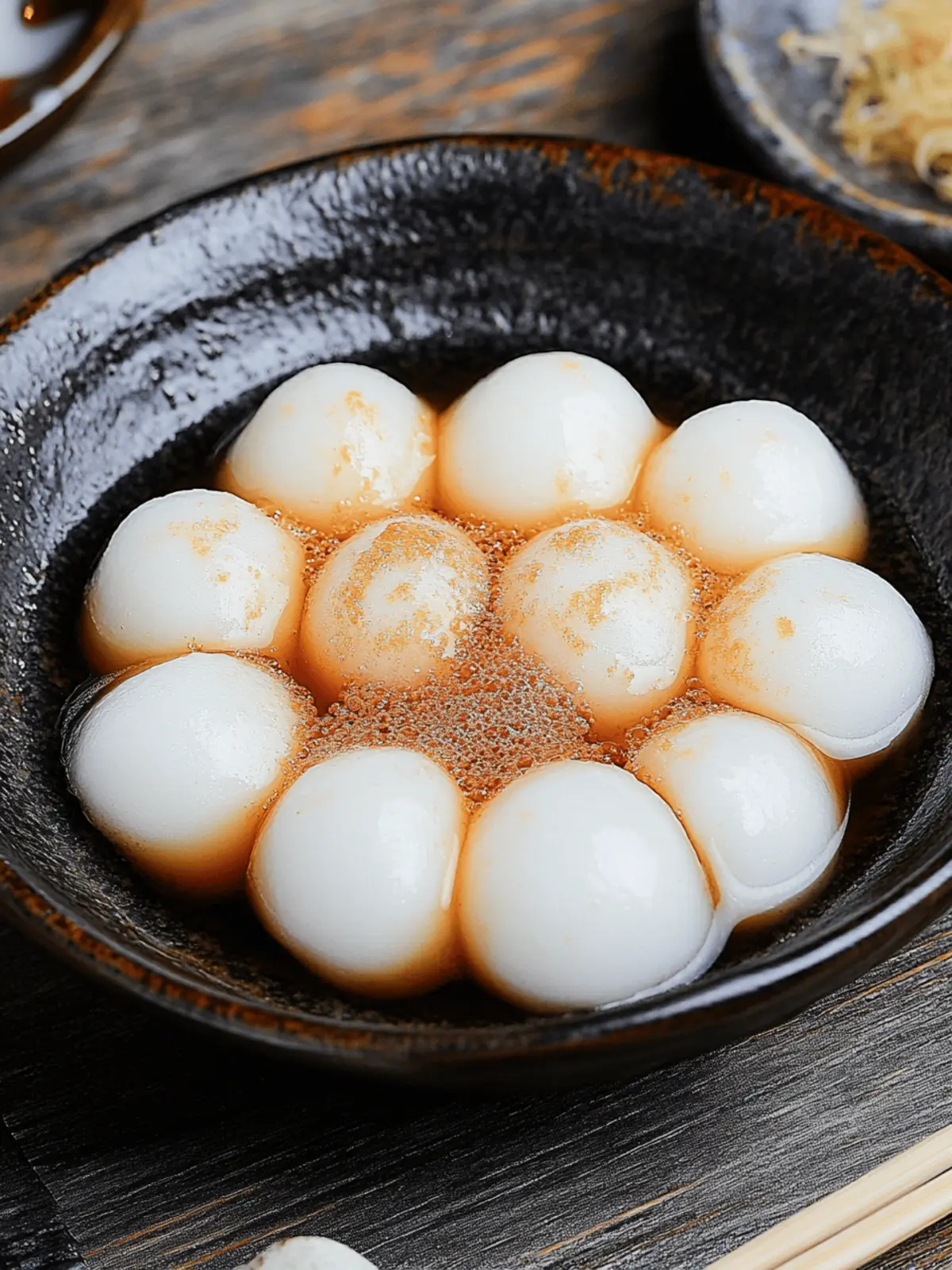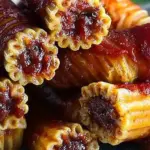There’s a special kind of joy that arises from crafting your own treats, and that feeling reaches new heights with Shiratama Dango. Picture this: soft, chewy mochi balls that practically beckon you to take a bite. Their delicate texture dances on your palate, making each morsel a delightful experience. Whether drizzled with a rich syrup or tossed in a nutty soybean powder, these traditional Japanese rice dumplings bring versatility and charm to any dessert table.
One day, I found myself yearning for something sweet yet simple. It was then that I rediscovered Shiratama Dango— a recipe that not only allows me to engage with my culinary side but also introduces a touch of Japanese culture to my home kitchen. With just a few ingredients, these gluten-free dumplings come together effortlessly, proving that delicious can also be straightforward. In just a matter of minutes, you’ll create a dish that’s pleasing to the eyes and the taste buds, leaving fast food far behind. Let’s dive into this delightful journey of flavor and texture!
Why is Shiratama Dango a must-try?
Delightful Chewiness: The texture of Shiratama Dango is simply irresistible, offering a satisfying chew that sets it apart from other desserts.
Easy to Make: With just a few ingredients and straightforward steps, you can whip these up in no time, making them perfect for any home cook.
Gluten-Free Adaptation: Enjoy this traditional treat without gluten concerns, ensuring everyone can partake in the deliciousness.
Versatile Toppings: From syrup to fresh fruits, the options for customizing your dango are endless—tweak it to suit your taste!
Cultural Experience: This recipe isn’t just about dessert; it’s a delightful way to connect with Japanese traditions right in your own kitchen.
Elevate your dessert game and impress your friends with this unique treat—make Shiratama Dango today!
Shiratama Dango Ingredients
For the Dango:
- Glutinous Rice Flour (Shiratamako) – This is the star of the show, providing that signature chewy texture.
- Water – Essential for binding the flour; add until you achieve a smooth, pliable dough.
Optional Toppings:
- Dark Brown Sugar Syrup (Kuromitsu) – Drizzle this for a sweet, rich flavor that enhances your dango experience.
- Roasted Soybean Powder (Kinako) – A delightful nutty addition that works wonders as a dusting over your dumplings.
Make sure to try creating Shiratama Dango at home—it’s a treat you won’t want to miss!
How to Make Shiratama Dango
-
Prepare the Flour: In a mixing bowl, add glutinous rice flour (shiratamako) and whisk it lightly, ensuring there are no clumps. This forms the base of your delightful dumplings.
-
Mix with Water: Gradually pour in half the water, mixing until fully incorporated. Add the remaining water slowly, kneading until you have a smooth, pliable dough. It should feel like a soft pillow!
-
Shape the Balls: Roll your dough into two cylinders, then cut each into 10 equal pieces. Roll each piece into a small ball, ensuring they’re uniform for even cooking.
-
Dent for Cooking: Use your finger to make a small dent in each ball. This helps with cooking and allows your toppings to soak in later. Lay them gently on baking parchment.
-
Boil the Dango: Bring a pot of water to a gentle boil. Carefully add the dango balls and cook until they float to the surface, which should take about 3 minutes. Let them cook for an additional minute once they float.
-
Cool and Serve: Transfer the cooked dango to a bowl of ice-cold water to cool for 5-10 minutes. Once chilled, serve with your desired toppings of syrup and soybean powder.
Optional: Drizzle with matcha syrup for a delightful twist!
Exact quantities are listed in the recipe card below.
Expert Tips for Shiratama Dango
-
Perfect Texture: Ensure your dough’s consistency is similar to softened earlobe; this is key to achieving that signature chewy Shiratama Dango.
-
Moisture Control: If the dough feels dry or cracks, simply wet your hands slightly before handling. This prevents it from becoming too crumbly.
-
Avoid Overcrowding: When boiling, work in small batches. Overcrowding the pot can cause the dumplings to stick together and cook unevenly.
-
Cooking Time: Keep an eye on the dango as they float; they need an extra minute after floating to ensure they’re fully cooked and soft.
-
Storage Tips: To keep leftover dango fresh, store them submerged in cold water in the fridge or freeze for future enjoyment. Make sure to reheat gently for the best texture.
What to Serve with Shiratama Dango?
Creating the perfect Shiratama Dango is just the beginning of an exciting culinary adventure! These delightful mochi balls deserve to be paired with equally scrumptious accompaniments.
-
Fresh Fruits: Sweet, sliced strawberries or ripe mangoes offer a refreshing contrast to the chewy texture of dango, adding bursts of natural sweetness.
-
Matcha Tea: The earthy bitterness of matcha complements the sweetness of the dango perfectly, creating a harmonious flavor experience that is utterly delightful.
-
Sweetened Condensed Milk: Drizzling this creamy goodness over warm dango adds a luscious richness and enhances the dessert’s indulgence.
-
Japan-inspired Fruit Salad: A mix of seasonal fruits tossed in a light honey-lime dressing brings a zesty freshness that balances the dense texture of your dango.
-
Ice Cream: A scoop of vanilla or matcha ice cream pairs beautifully, providing a cold, creamy contrast to the warm, chewy dumplings for an indulgent treat.
-
Kuromitsu: This dark brown sugar syrup is a traditional topping that intensifies the sweetness and mimics the beloved flavors of classic Japanese sweets.
-
Coconut Cream Sauce: A drizzle of creamy coconut adds a tropical flair, elevating the deliciousness of the Shiratama Dango while keeping it light.
-
Traditional Mochi Ice Cream: Combine with another Japanese favorite by serving dango alongside a few bites of mochi ice cream to create a delectable dessert platter.
With these pairings, your Shiratama Dango experience will transcend ordinary desserts, inviting everyone to savor each delightful flavor!
Make Ahead Options
Shiratama Dango is perfect for meal prep enthusiasts looking to save time without sacrificing quality! You can prepare the dough for these delightful rice dumplings up to 24 hours in advance. Simply follow the mixing steps, shape the balls, and place them on baking parchment; then refrigerate them until you’re ready to cook. This keeps them fresh and prevents drying out. When you’re ready to serve, boil the refrigerated dango until they float, which typically takes about 3 minutes. By prepping ahead, you’ll enjoy a quick dessert that tastes just as delicious as if you made it on the spot!
Storage Tips for Shiratama Dango
Fridge: Place any leftover Shiratama Dango in a bowl of cold water and cover it. They will stay fresh for up to 3 days.
Freezer: For longer storage, freeze the dango on a parchment-lined tray. Once solid, transfer them to a sealable bag, ensuring to consume within a month.
Reheating: To reheat, immerse the dango in warm water or microwave gently, avoiding overheating to maintain their chewy texture.
Airtight Storage: If you prefer to store dango without water, keep them in an airtight container in the fridge, but consume them within 1-2 days for optimal freshness.
Shiratama Dango Variations
Feel free to get creative with your Shiratama Dango and customize it to suit your tastes!
-
Mochiko Alternative: Use mochiko instead of shiratamako for a slightly different texture, while maintaining that charming chewiness.
Experiment with both flours and discover how each brings a unique touch to this classic recipe! -
Matcha Twist: Add 1-2 teaspoons of matcha powder to the dough for a beautiful green hue and earthy flavor that complements the sweetness perfectly.
This matcha infusion takes your dango to a whole new level—ideal for enthusiasts of Japanese flavors. -
Fruit-Infused Dango: Incorporate pureed fruits like strawberry or mango into the dough for a fragrant, fruity twist.
This not only enhances flavor but also adds a delightful pop of color, making your dango visually appealing! -
Sweetener Swap: Replace brown sugar syrup with honey, maple syrup, or agave nectar for a different kind of sweetness that caters to your preferences.
Exploring new sweeteners can create delightful combinations, expanding the potential of your dango experience! -
Nutty Delight: Try dusting your dango with chopped nuts like almonds or hazelnuts for added crunch and flavor.
The contrast between soft dumplings and crunchy nuts makes for an enticing treat that will leave everyone craving more! -
Savory Option: For a unique spin, incorporate spices like black sesame or a pinch of salt into the dough for a savory version of shiratama dango.
This unexpected twist is perfect for adventurous eaters looking to explore diverse flavor profiles! -
Chocolate Surprise: Mix cocoa powder into the dough for a rich chocolate flavor, making these dumplings a decadent treat.
Serve with a drizzle of chocolate or a scoop of ice cream to create a delightful dessert experience!
With these variations, each batch of Shiratama Dango can offer a new culinary adventure, enticing your taste buds every time!
Shiratama Dango Recipe FAQs
What type of glutinous rice flour should I use for Shiratama Dango?
Absolutely! You should use Shiratamako, which is the traditional glutinous rice flour for making Shiratama Dango. If you can’t find it, you can opt for Mochiko as a suitable alternative. Both types of flour yield a chewy texture, but Shiratamako is the most authentic choice.
How should I store my leftover Shiratama Dango?
To keep your leftover Shiratama Dango fresh, place them in a bowl of cold water and cover with plastic wrap, storing in the fridge for up to 3 days. If you need to store them for longer, freeze the dango on a parchment-lined tray until solid, then transfer to a sealable bag. They will stay good in the freezer for about a month.
Can I freeze Shiratama Dango? What’s the best way to do it?
Yes, you can absolutely freeze Shiratama Dango! First, cook them as per the recipe, then let them cool completely. Spread the dango on a parchment-lined tray without touching each other and freeze for a few hours until firm. Transfer the frozen dumplings into a sealable bag, and they can be stored for up to 3 months! When ready to eat, just reheat them gently in warm water or a microwave, being careful not to overheat.
What if my dango dough is too dry or cracks?
Very good question! If your dango dough feels dry or cracks while shaping, don’t fret! Just wet your hands slightly before handling the dough. This small adjustment adds just enough moisture to bring it together beautifully. You can also add a splash of water to the mixture if needed, kneading until it’s smooth again.
Is Shiratama Dango safe for people with gluten allergies?
Yes! Since Shiratama Dango is typically made with glutinous rice flour, it is naturally gluten-free. However, always double-check your flour brands to ensure they are certified gluten-free, especially if you’re cooking for someone with celiac disease. Feel free to customize the toppings too, ensuring they align with your dietary requirements.
How can I tell when the Shiratama Dango are fully cooked?
Great question! The Shiratama Dango are cooked properly when they float to the surface of the boiling water, usually in about 3 minutes. After they float, let them cook for an additional minute for the best texture. They should feel soft and slightly sticky to the touch—just perfect for enjoyment!
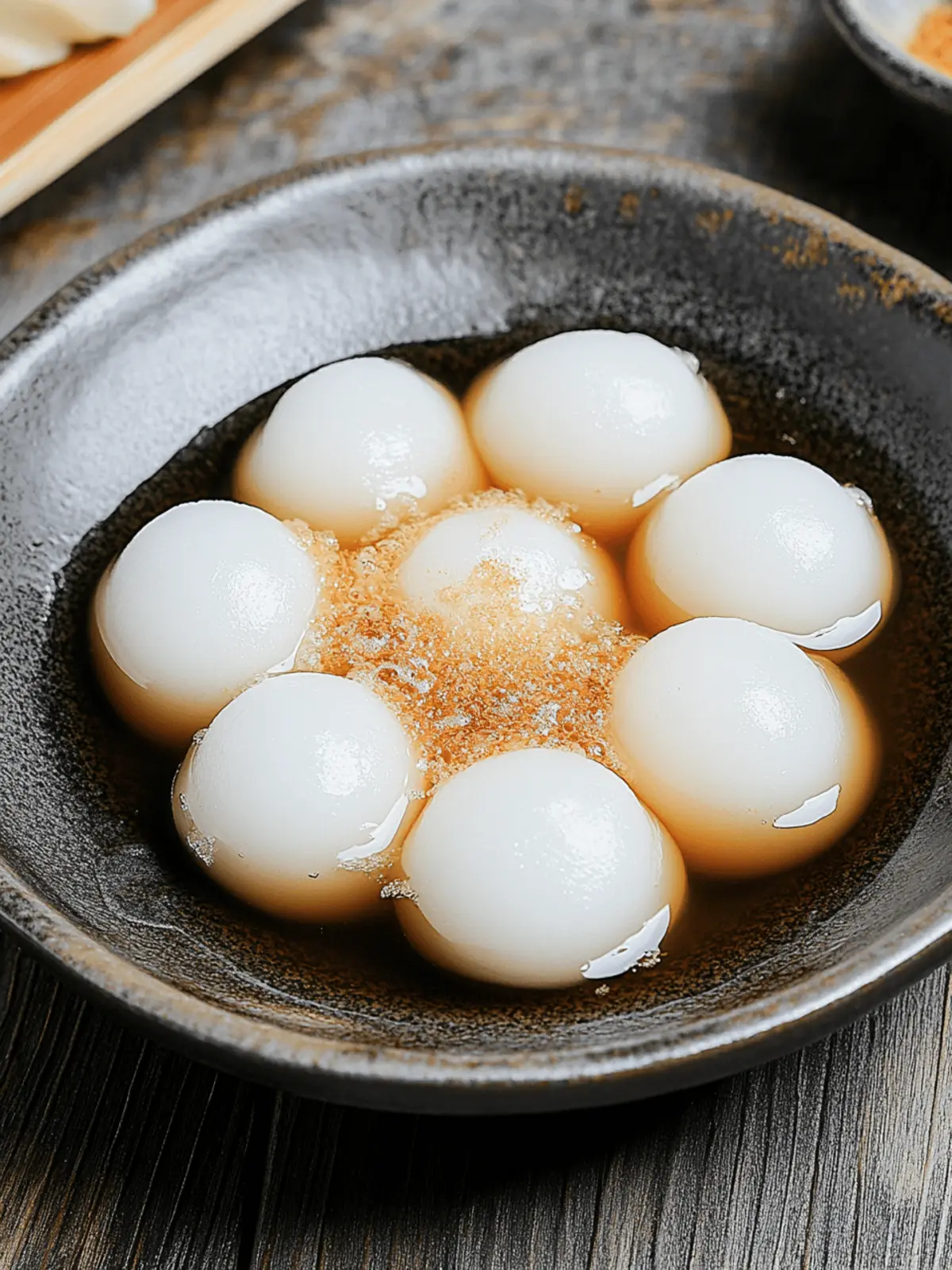
Delicious Shiratama Dango: Easy Japanese Rice Dumplings at Home
Ingredients
Equipment
Method
- In a mixing bowl, add glutinous rice flour (shiratamako) and whisk lightly to ensure no clumps form.
- Gradually pour in half the water, mixing until fully incorporated, then add the remaining water slowly, kneading until you have a smooth, pliable dough.
- Roll the dough into two cylinders, cut each into 10 equal pieces and roll them into uniform small balls.
- Make a small dent in each ball for cooking and to allow toppings to soak in later.
- Bring a pot of water to a gentle boil, carefully add the dango balls and cook until they float (about 3 minutes), then cook for an additional minute.
- Transfer cooked dango to ice-cold water to cool for 5-10 minutes before serving with toppings.

